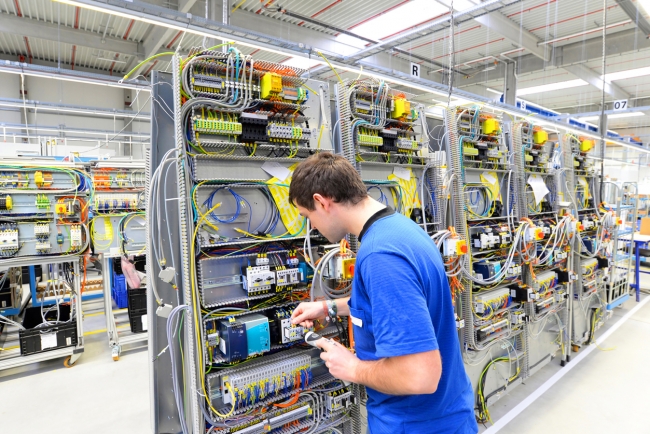6 minute read • published in partnership with Potter Clarkson
Insight: How building a strong brand helps you build a stronger manufacturing business
Over two thirds of British manufacturers say they intend to focus on brand related investments now or within the next two years. Emmy Hunt from Potter Clarkson explores the data and looks at how a strong brand helps build a stronger manufacturing business.
When we think about manufacturing, we tend to think more about engineering processes, machinery, innovative materials, and mass market products. This is because historically, manufacturing businesses developed as either product-led businesses or engineering-led businesses. Their focus was on the expertise and innovative technology needed to take a product either from concept to market or from engineering problem to solution.
This is why it was so interesting to see Make UK’s 2024 Executive Survey of the manufacturing industry highlighting that, after upskilling/retraining staff and new product development, the next highest priority investment area for interviewees was brand development and marketing. 53% of those interviewed said they were addressing their brand and 18.5% said they were planning to look at their brand within the next 24 months.

Picture: Getty/iStock
The statistics match our recent experiences in the manufacturing sector. We see more businesses across different manufacturing lines increasing their investment in their name and brand identity. Their brand better articulates the message they convey to their customers and can be used in more potent ways to elicit a positive response with positive purchasing behaviour from their target market.
It is important to remember that a brand-led approach to manufacturing isn’t about applying a nice brand to an existing manufacturing business. Brand-led manufacturing is about creating value in a business that extends beyond products or processes that typify most manufacturing businesses. It merges the different design, manufacturing, and marketing activities to deliver a consistent brand message that adds value to the business overall.
A brand-led approach allows manufacturers to unlock their competitive advantage. Integrating their brand and marketing into the development of new products allows manufacturers to not only deliver the key functional requirements but also reflect and reinforce the different elements of their brand more prominently.
So, what do we mean by reflecting and reinforcing a brand?
It could mean embodying the brand’s core values in a physical way. It could involve improving the user experience. It could involve employing specific design aesthetics such as an unusual shape or colour or innovating new and unique features. It could involve developing new manufacturing methods, such as additive manufacturing, or innovative materials, that bring a uniqueness or quality to the product that is different to the rest of the market. It could even signify the development of a new market that has a focus beyond merely the manufactured product.

Picture: Getty/iStock
Above all else, moving to a brand-led approach to manufacturing means combining the innovation and engineering side of the business with the commercial and strategic direction of the business.
Perhaps the easiest way to explain brand-led manufacturing is to share three examples of leaders in the field.
Dyson was originally known for its innovative vacuum cleaners. It’s now known for its fans, hair styling products and other household appliances having created a brand based on innovative technology, performance, and design. They invest heavily in R&D that produces products that complement exceptional performance with a sleek, modern look that is easily recognisable as a ‘Dyson’ product.
Porsche is associated with precision engineering, exceptional performance, and luxury. The Porsche business extends from high-performance cars to a product range that includes everything from sunglasses and handbags to a luxury apartment building in Miami. All these products share a commitment to quality and performance and allow a broader range of consumers to enjoy the Porsche ‘experience’ without purchasing a car.
Apple has always been recognised for its meticulous attention to design and efforts to provide the very best and consistent user experience. From the iPhone to the MacBook, they have created brand that articulates simplicity, elegance, and innovation by creating a working environment in which their engineers work hand in glove with their designers. That design focus has not only helped to revolutionize a new market space but also developed a strong and unified brand around a range of different products within a consistent marketing strategy.

Picture: Getty/iStock
How does brand help build stronger manufacturing businesses?
There are several tangible, short-term benefits to establishing a stronger brand within which your manufacturing business can operate.
You’ll increase customer loyalty. A strong brand message will resonate with your market. This will help you convert first-time customers and then retain their business, even encouraging them to purchase other options from your product line. Customer loyalty also pays dividends when you diversify and bring new products to market.
Establishing a positive brand identity will help you to stand out from your competitors for all the right reasons. In a market where your competitors may not be capitalising on their own brand value, this can differentiate your business, allowing you to command premium pricing and increase visibility to existing and new customers.
Another reason to establish a positive brand identity is to provide a more powerful marketing message with which to create credible, consistent, and compelling marketing campaigns that maximise customer engagement and, ultimately, generate more business.
Adopting a strong brand under which your primary manufacturing business can grow could also provide a stronger platform for future innovation. Once your brand is defined and successful in the market, you can use it to de-risk continued innovation, when you improve existing products, collaborate with other businesses, or create new complementary product lines.
However, from a purely IP perspective, implementing a brand-led approach will allow you to build a more valuable IP portfolio. Protecting your brand using registered IP rights will grow into a portfolio of rights that will attract partners and investors and increase the value of business should you decide to expand or sell.

Picture: Getty/iStock
The first step is to establish the required protection for your brand. This will not only create value (although that is, of course, an objective) protection will also:
• Provide you with security if you wish to scale up your manufacturing processes. Moving your manufacturing base to a cheaper country is an attractive option for many manufacturers but it comes with risk. One of the main risks is infringement. Obtaining IP rights will allow you to take enforcement action against infringers.
• Open up licensing opportunities. Licensing will allow you to capitalise on new markets with a demand for your products but where you have neither the expertise nor the investment to develop those products yourself. Securing registered rights will allow you to capitalise on these licensing opportunities and recognise royalties.
• Tackle the risk of counterfeiting. When counterfeiters see a product doing well, they’ll try and copy it. This doesn’t only impact designer brands, and we now regularly see copycat products in every area of technology including heavy machinery, spare parts and accessories. In the manufacturing industry, poor quality counterfeits not only lead to lost revenue but can threaten lives.
• Provide you with a more expansive brand strategy that can be rolled into new territories and new markets with new products. if this in your plans you need to ensure that your brand will work for this anticipated wider use and register the required rights before you launch.
• Enable you to create the strongest possible “house” brand for your sub-products and their own individual sub-brands. A strong “house” brand will ensure that you continue to benefit from the goodwill created in your new product lines and vice-versa, that this connection with your house brand will drive people towards your new products.
